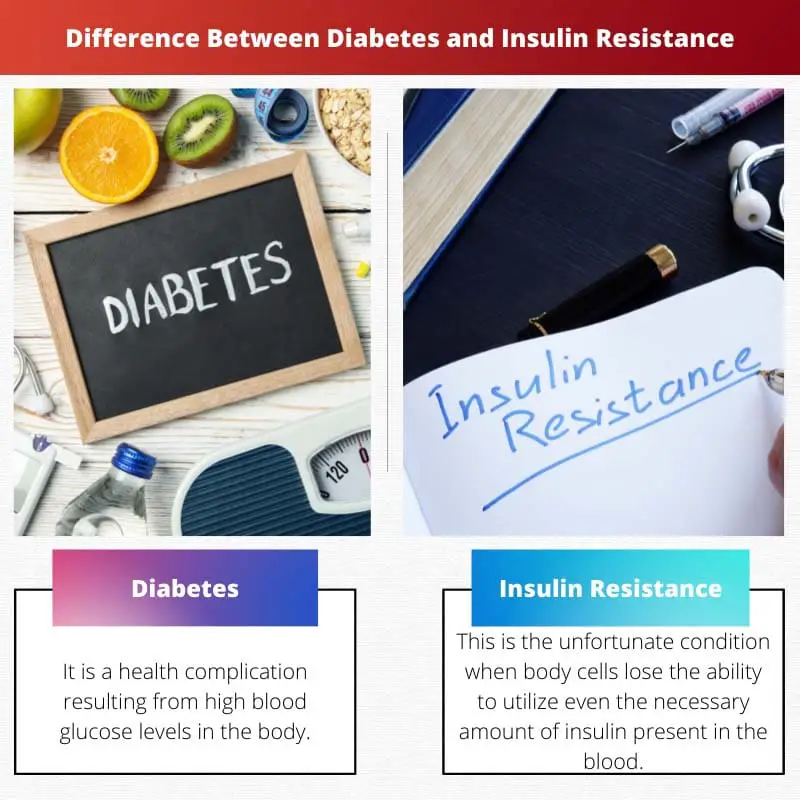Blood sugar levels in the body need to be regulated for optimum health.
With changes in eating habits and other problems like hypertension, diabetes has become a prominent issue among people of all ages. Insulin resistance is also a related issue.
Key Takeaways
- Diabetes is when the body cannot produce or properly use insulin, whereas insulin resistance is when the body’s cells become less responsive to insulin.
- Diabetes can lead to high blood sugar levels, whereas insulin resistance can lead to prediabetes or type 2 diabetes.
- Diabetes is treated with insulin injections or oral medication, whereas insulin resistance can be treated with lifestyle changes, such as diet and exercise.
Diabetes vs Insulin Resistance
Diabetes is a metabolic disorder characterized by high blood sugar levels due to a deficiency in insulin production or impaired insulin function. Insulin is a hormone the pancreas produces that helps regulate blood sugar levels. Insulin resistance occurs when the body is exposed to high insulin levels over a prolonged period.

Diabetes is most commonly referred to as a sugar-related disease. People cut down on sugary foods and try to have alternatives that do not increase the fasting rate.
Self-diagnosis includes the frequent urge to urinate more than usual.
Insulin Resistance is more complicated than diabetes. It is a cellular disease and has nothing to do with sugar levels in the body shooting up and dropping down.
Exercising daily is a part of the aftercare routine.
Comparison Table
| Parameters of Comparison | Diabetes | Insulin Resistance |
|---|---|---|
| Pharmaceutical Definition | It is a health complication resulting from high blood glucose levels in the body. | This is the unfortunate condition when body cells lose the ability to utilize even the necessary amount of insulin present in the blood. |
| Prominent Symptoms Observed | Nausea and fatigue might occur repetitively. | Visible symptoms include skin darkening in the upper half of the body, mostly the skin folds. |
| Remedies Available | Administration of insulin, mainly through injectables. | Medicines like metformin are to be consumed regularly. |
| After-effects of prolonged existence | Might damage the vital nerves of the body. | After some time, type two diabetes might be developed (in severe cases only) |
| Oral Glucose Tolerance Levels (in mg/dL) | Above 200. | Between 150 and 200. |
What is Diabetes?
Diabetes is a common disease that leads to weakness. When blood sugar levels shoot up, the utilization of glucose in the body and the subsequent metabolism is hampered.
In most cases, eyesight is also affected early on. The most common treatment for this disease is the regular administration of insulin injections to reduce blood sugar levels.
On the other hand, overdosing on insulin might also prove fatal.
Apart from the categorical distinctions, this disease also has further classifications. Diabetes is mainly classified into two types – type one diabetes and type two diabetes.
Type 1 is associated with autoantibodies developing at a faster rate in the body, which becomes uncontrollable in the long run.
On the other hand, type 2 diabetes is mostly linked with obesity and hypertension. Cholesterol also plays a significant role.
Though many alternatives are available, it is advisable to confirm for greater accuracy. Kids can also become afflicted with diabetes, not necessarily due to the predominance of the same in either of the parents.
In elderly people, the causal factors of diabetes include autoimmune reactions of the body and a sedentary lifestyle.
Diabetes keeps on fluctuating based on the preventive measures taken by the patient. There is no permanent treatment, but the disease is curable.

What is Insulin Resistance?
Insulin Resistance occurs mostly in the later stages of life, once a person ages fifty. There have been negligible cases of kids and young adults suffering from the same.
Due to innate complications and hereditary factors, the body cells are unable to extract insulin from the blood. This, in turn, leads to the misappropriation of sugar levels in the long run.
Type two diabetes is the result of the same.
Insulin Resistance can be identified by looking out for external changes like decolouration of the skin. The most prominent areas include the chin and around the upper arms.
Obesity is also believed to have links with this disease, as established by various biomedical researchers.
Insulin Resistance has no immediate treatment as of now. People are advised to maintain a healthy lifestyle and lose weight.
The conversion into diabetes can easily be prevented by complying with guidelines, as type two diabetes is more fatal than inulin resistance.
At times, genetics is not the only cause to blame. Lifestyle habits might also cumulatively lead to an imbalance inside the circulatory system, causing complications.
Though insulin resistance is mostly confused with type two diabetes, it is just the initial stage.
Main Differences Between Diabetes And Insulin Resistance
- Diabetes is defined as the shooting up of blood sugar levels in the body, whereas insulin resistance is defined as the improper intake of insulin by the body cells from the existing amounts in the blood.
- A person suffering from diabetes might feel nauseous and might not feel energetic in normal conditions. On the contrary, insulin resistance has no physiological symptoms apart from the darkening of the skin.
- The treatment procedure for curing diabetes includes injecting the patient with the optimum amount of insulin to replenish the levels. Since there is no way to modify the cells, drugs like metformin are prescribed to people suffering from insulin resistance.
- If left untreated for longer, diabetes might ultimately culminate into partial or complete nerve damage. On the other hand, insulin resistance is the predecessor of type two diabetes.
- On proper checkup, the observed oral glucose tolerance levels cross the two hundred mark in a diabetic while they remain below 200 and above 150 in patients who are diagnosed with insulin resistance.




